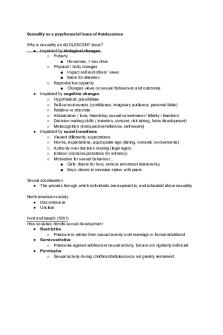Human Sexuality Sexual affectional Orientation & Diversity WEEK 4 ( Lecture Notes) PDF

| Title | Human Sexuality Sexual affectional Orientation & Diversity WEEK 4 ( Lecture Notes) |
|---|---|
| Course | Human Sexuality |
| Institution | George Brown College |
| Pages | 3 |
| File Size | 97.8 KB |
| File Type | |
| Total Downloads | 3 |
| Total Views | 142 |
Summary
This course focuses on issues regarding sexuality...
Description
Human Sexuality (LECTURE NOTES) SEXUAL AFFECTIONAL ORIENTATION & DIVERSITY Affectional or Romantic Orientation
Sexual orientation is now identified as Affectional or Romantic Orientation o sex or gender with which a person is most likely to have a romantic relationship or fall in love with The term homosexual entered the English language in 1869 The term homosexual was not so much about doing a behaviour, but about being a certain type of person
Identity Labels
Labels are social constructions that include o information about sexual/romantic preference, o certain self-perceptions (“I am lesbian”), o worldviews (political support for female solidarity, etc.) Terms such as gay, queer, and heterosexual are more accurately used as adjectives than nouns o they refer to an identity and not an individual’s “essence”
Asexuality
Asexual individuals may fall in love romantically with another person without feeling sexual desire for her or him May have a masturbation frequency that falls in the normal range May or may not acquire an asexual identity
Prejudice against Same-Sex Oriented Individuals
Upper classes were more positive about homosexual love, but the majority of citizens were not Conversion Therapy o “Pray away the gay” o Reparative therapy highly contested o There is no proven method to change someone’s sexual orientation
Theories of Affectional Orientation and Sexual Identity Development
Affectional orientation has many aspects, including sexual attraction, sexual fantasies, and sexual preference
Psychosocial Explanations
Most gay and lesbian individuals were raised by heterosexual parents, and most children of same-sex parents are heterosexual There is no evidence that trauma (such as early sexual abuse) affects sexual orientation A change in Affectional orientation appears to be more fluid in females
Sexual Identity Development
Ecological theory based on how people interact with their environment o E.g. model recognises that identity formation and disclosure will be quite different for a white atheist male raised in Laguna California, USA and a practicing Muslim male from Lebanon.
Self-Identification and Identity Disclosure
Some individuals may have internalized homophobia that blocks such healthy selfacceptance Process of accepting oneself and a particular sexual identity label Some LGBTQ individuals have good reason to not disclose: o anticipated negative family reaction o fear discrimination and social stigma
Intimate Relationships
Research reports that lesbian couples report greater relationship satisfaction than either gay or heterosexual couples Non-monogamous gay couples are as happy as monogamous gay couples
Bisexuality and Relationships
Freud believed we are all born bisexual There has never been a society where the number of same-sex relationships equal that of mixed-sex relationships Most bisexual people have a history of heterosexual relationships before they have samesex interests Some bisexual people are monogamous, others have multiple partners Relatively small number of individuals identify as bisexual – may suffer from being seen as “fence-sitters”
Same-Sex Sexual Behaviour
Gay men in relationships report the most sex, lesbian couples have the least, and mixed couples fall in between Gay males have 42.8 partners on average in a lifetime, heterosexual males have 16.5, lesbian women 9.4, and heterosexual women 4.6 Typical order of sexual activities for boys who have sex with other boys: oral sex, anal sex, anilingus, and anal dildo penetration Typical order of sexual activities for men who have sex with other men: mutual masturbation, oral sex, and anal intercourse Most common sexual activities for women who have sex with other women include oral sex, vaginal–digital penetration, and mutual masturbation
Coming Out as a Process
Uncertainty Fear Isolation Alienation Denial Identity Acceptance Homophobia Loss Connection...
Similar Free PDFs

Human Sexuality Notes PDF
- 30 Pages

Human sexuality chapter 5 notes
- 2 Pages

Human sexuality sex education
- 3 Pages

Week 4 - Lecture notes 4
- 5 Pages

Week 4 - Lecture notes 4
- 5 Pages

Week 4 - Lecture notes 4
- 3 Pages

Sexuality - Lecture notes 7
- 8 Pages

Human sexuality- paper 1
- 3 Pages
Popular Institutions
- Tinajero National High School - Annex
- Politeknik Caltex Riau
- Yokohama City University
- SGT University
- University of Al-Qadisiyah
- Divine Word College of Vigan
- Techniek College Rotterdam
- Universidade de Santiago
- Universiti Teknologi MARA Cawangan Johor Kampus Pasir Gudang
- Poltekkes Kemenkes Yogyakarta
- Baguio City National High School
- Colegio san marcos
- preparatoria uno
- Centro de Bachillerato Tecnológico Industrial y de Servicios No. 107
- Dalian Maritime University
- Quang Trung Secondary School
- Colegio Tecnológico en Informática
- Corporación Regional de Educación Superior
- Grupo CEDVA
- Dar Al Uloom University
- Centro de Estudios Preuniversitarios de la Universidad Nacional de Ingeniería
- 上智大学
- Aakash International School, Nuna Majara
- San Felipe Neri Catholic School
- Kang Chiao International School - New Taipei City
- Misamis Occidental National High School
- Institución Educativa Escuela Normal Juan Ladrilleros
- Kolehiyo ng Pantukan
- Batanes State College
- Instituto Continental
- Sekolah Menengah Kejuruan Kesehatan Kaltara (Tarakan)
- Colegio de La Inmaculada Concepcion - Cebu







